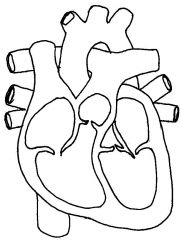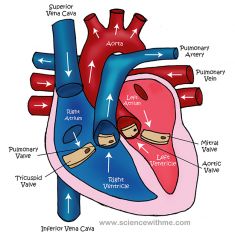![]()
![]()
![]()
Use LEFT and RIGHT arrow keys to navigate between flashcards;
Use UP and DOWN arrow keys to flip the card;
H to show hint;
A reads text to speech;
29 Cards in this Set
- Front
- Back
|
What is the function of the circulatory system? |
To deliver or remove nutrients, oxygen and other necessary substances to all cells of a multi-cellular organism |
|
|
What are the 3 types of blood cells? |
White blood cells, red blood cells and platelets |
|
|
What are erythrocytes often referred as? |
Red blood cells |
|
|
What is haemoglobin? |
A protein that binds to oxygen |
|
|
What are leucocytes more commonly known as? |
White blood cells |
|
|
What is the main function of white blood cells? |
They help destroy bacteria or viruses by either releasing chemicals to kill them or by surrounding them and destroying them |
|
|
What is the function of plasma? |
They trigger the production of fibrin which is what forms a clot to stop bleeding |
|
|
What are the 3 main jobs of blood? |
1. Takes things to the cells that they need (nutrients, oxygen) 2. takes waste away from the cells (carbon dioxide) 3. Delivers heat from the liver to keep the body warm |
|
|
What are the types of blood vessels and what order do they go in? |
Arteries, arterioles, capillaries, venules and veins. |
|
|
What do arteries do? |
Carry blood away from the heart |
|
|
What is your pulse? |
Your pulse if the blood passing through the arteries at certain parts of the body |
|
|
Which artery does not carry oxygenated blood? |
Pulmonary artery |
|
|
What is the main artery that leaves the heart? |
The aorta |
|
|
What are capillaries? |
Small blood vessels that are one cell thick. Because they are so thin, gasses, nutrients, etc. can diffuse through them. |
|
|
What are veins? |
Veins take blood back to the heart |
|
|
Why are the walls of veins thinner than the one's of arteries? |
Because by then the blood in the veins has done a lap of the body. Some has been lost to the lymphatic system and the remaining fluid is therefore under less pressure |
|
|
What type of circulatory system do mammals and birds have and what is it? |
They have a closed double circulatory system. Double meaning that there are two pumps of the heat per lap of the body. Closed meaning blood is in vessels so de-oxygenated blood and oxygenated blood don't mix. |
|
|
What type of circulatory system do amphibians and reptiles have and what is it? |
They also have a closed (mostly) double system but a 3 chambered heart which allows for mixing of blood in the ventricle. |
|
|
What type of circulatory system do fish have and what is it? |
They have a closed single circulatory system. Blood doesn't mix but it's at a low pressure when it becomes oxygenated at the gills. |
|
|
What type of circulatory system do insects have and what is it? |
Insects have an open circulatory system. The blood is in vessels for some of the time only and it carries ions, sugar, etc. but not oxygen |
|
|
What is the lymphatic system? |
A series of vessels that collect fluid that escapes from the capillaries. It returns fluid to the circulatory system. |
|
|
What do lymph nodes do? |
They filter plasma for pathogen and retain them for destruction by the immune system |
|
|
Why do we need to exchange gas? |
CO2 can be toxic if it builds up and O2 is required by the cells for aerobic cellular respiration |
|
|
What are the sites for gas exchange? |
Alveoli of the lung and in capillaries |
|
|
Describe the process of breathing. |
Air enters via the mouth or nose, it then passes through the pharynx or trachea. As we inhale, the diaphragm contracts and pulls the ribs out which expands the chest cavity. This creates a vacuum which sucks air in. When the diaphragm rises, the ribs push back in which contracts the chest cavity, forcing air out. |
|
|
What does the urinary system do? |
The urinary system filters blood, regulates water levels in the body and disposes of excess nitrogen |
|
|
Why would mammals of a dry environment have a long loop of henle? |
To maximise water reabsorption as they do not get much water from their environment. |
|
|
Why do seabirds excrete uric acid? |
To conserve H2O |
|

Label the parts of the heart |

|

